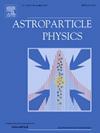A new method for detecting heavy cosmic ray component above the knee region
IF 2.9
3区 物理与天体物理
Q1 ASTRONOMY & ASTROPHYSICS
引用次数: 0
Abstract
The precise energy spectrum of cosmic rays with different compositions is crucial for studying the origin of cosmic rays (CRs). Spectral features of single-component spectra provide an opportunity to investigate the acceleration and propagation of the “knee”. Ground-based experimental measurements of secondary particles are influenced by energy components and hadronic interactions, leading to significant uncertainties in component-specific energy spectra. The intensity of the direct Cherenkov (DC) light emitted by the primary cosmic ray particles is proportional to the square of their charge (), which serves as a valuable parameter for component discrimination. The fluorescence yield is proportional to the energy of primary cosmic ray, which can be used to reconstruct the primary particle’s energy. This project proposes a new method for measuring heavy components at the knee region: hybrid measurements combining direct Cherenkov and fluorescence detection at the high altitudes of the stratosphere. In this paper, the characterization of direct Cherenkov and fluorescence at high altitudes has been investigated, and a conceptual detector has been proposed based on the results of the study. Finally, preliminary simulation results indicate that the aperture is 85.98 and retention ratio for Fe is approximately .
一种探测膝部以上重宇宙射线成分的新方法
不同成分宇宙射线的精确能谱对于研究宇宙射线的起源至关重要。单组分光谱的光谱特征为研究“膝盖”的加速和传播提供了机会。二次粒子的地面实验测量受到能量组分和强子相互作用的影响,导致组分特异性能谱存在显著的不确定性。原始宇宙射线粒子发射的直接切伦科夫(DC)光的强度与它们的电荷(Z2)的平方成正比,这是一个有价值的成分判别参数。荧光产率与初级宇宙射线的能量成正比,可以用来重建初级粒子的能量。本项目提出了一种测量膝部重组分的新方法:在平流层高海拔处结合直接切伦科夫和荧光检测的混合测量。本文研究了直接切伦科夫和荧光在高海拔的特性,并根据研究结果提出了一种概念探测器。最后,初步模拟结果表明,孔径为85.98 m2sr,铁截留率约为0.8153±0.0017。
本文章由计算机程序翻译,如有差异,请以英文原文为准。
求助全文
约1分钟内获得全文
求助全文
来源期刊

Astroparticle Physics
地学天文-天文与天体物理
CiteScore
8.00
自引率
2.90%
发文量
41
审稿时长
79 days
期刊介绍:
Astroparticle Physics publishes experimental and theoretical research papers in the interacting fields of Cosmic Ray Physics, Astronomy and Astrophysics, Cosmology and Particle Physics focusing on new developments in the following areas: High-energy cosmic-ray physics and astrophysics; Particle cosmology; Particle astrophysics; Related astrophysics: supernova, AGN, cosmic abundances, dark matter etc.; Gravitational waves; High-energy, VHE and UHE gamma-ray astronomy; High- and low-energy neutrino astronomy; Instrumentation and detector developments related to the above-mentioned fields.
 求助内容:
求助内容: 应助结果提醒方式:
应助结果提醒方式:


